 Edit article
Edit articleSeries
Megiddo’s Stables: Trading Egyptian Horses to the Assyrian Empire

Reconstruction of Building 338; Herbert May Collection, Oberlin College
The city of Megiddo is mentioned 11 times in the Hebrew Bible. It is described as,
- Canaanite City—One of the Canaanite cities whose king Joshua kills (Josh 12:21), and which goes unconquered by Joshua and the early Israelites (Josh 17:11, Judg 1:27), though it becomes part of Manasseh’s territory (1 Chron 7:29).
- Israelite City—The city is part of Israel during Solomon’s reign (1 Kgs 4:12), who is said to have built it up (1 Kgs 9:15). King Ahaziah tries to escape assassination by fleeing there, but died there after being struck by Jehu (2 Kings 9:27). Most famously, it is where King Josiah was killed by Pharaoh Necho (2 Kings 23:29–30).
- Locus of Battles—The site of battles and death in the Bible: Barak fights Sisera near מי מגדו, the waters of Megiddo (Judg 5:19), and Josiah fights Pharaoh Necho in בקעת מגדו, the valley of Megiddo (2 Chron 35:22).
The description of great battles fought near Megiddo is not merely a biblical trope, but a historical reality. For example, in ancient times, Pharaoh Thutmose III fought a battle against a coalition of Canaanite city states near Megiddo in the 15th century B.C.E. In medieval times, the decisive defeat of the Mongols in 1260 C.E. by the Egyptian Mamluk dynasty in the Battle of Ain Jalut (“Goliath’s Spring,” מעין חרוד) took place not far from Megiddo. The city’s strategic importance is due to its being located in the Jezreel Valley, on one of—if not the—most important trade routes in the ancient world, known as the Via Maris or “Way of the Sea.”[1]
Today Megiddo is one of the most visited National Parks in Israel. Schoolchildren, usually in 4th or 5th grade, visit with their teachers, and tourists include it in their itinerary. Christian pilgrims visit because the book of Revelation names it as the site of the final battle, when three evil spirits will go out to all the kings of the world, “And they assembled them at the place that in Hebrew is called Armageddon” (Rev 16:16). Armageddon is a Grecized version of הר מגידו, “Mount Megiddo.”
Archaeological Exploration of Megiddo: A Timeline
Megiddo has been explored and excavated by archaeologists since it was first securely identified by Gottlieb Schumacher, who conducted the first excavations at Megiddo between the years 1903 and 1905.[2] Schumacher was an engineer turned archaeologist, a member of the Templar Colony in Haifa, and his excavations, although not very scientifically reliable, uncovered architecture and finds that could be attributed to the period of the Hebrew Bible.
Oriental Institute of Chicago and Center in Luxor
Knowing that the great biblical city of Megiddo was waiting to be revealed prompted the Oriental Institute of Chicago to launch a large-scale excavation there in 1925. Since the Oriental Institute maintained a permanent research and excavation center in the Middle East—namely at Egyptian Luxor, where they had had spectacular success in uncovering the wonders of ancient Egypt—it was convenient for them to add another excavation. Plus, they felt that the excavation of Megiddo would provide them with material finds that could open up the world of the Bible the way their findings in Egypt opened up ancient Egyptian society.
The center put together an excavation team directed by Clarence Fisher, who as a former member of the Harvard excavation team at Samaria (שמרון, the capital of the Kingdom of Israel), had valuable excavation experience. Fisher brought with him a team of skilled Egyptian workers who would be responsible for training and overseeing the local, as yet unskilled, labor.
Due to ill health, Fisher retired after less than two years of excavation. Fortunately, a replacement was quickly found, Philip Langstaff Orde Guy (commonly known as P.L.O. Guy), a British archaeologist on the staff of the Department of Antiquities of the British Mandate.
Guy, although a Christian, had married Yemima Ben-Yehuda, the eldest daughter of Eliezer Ben-Yehuda, and was an ardent Zionist, eager to help reveal the history of the Jewish people in their land.
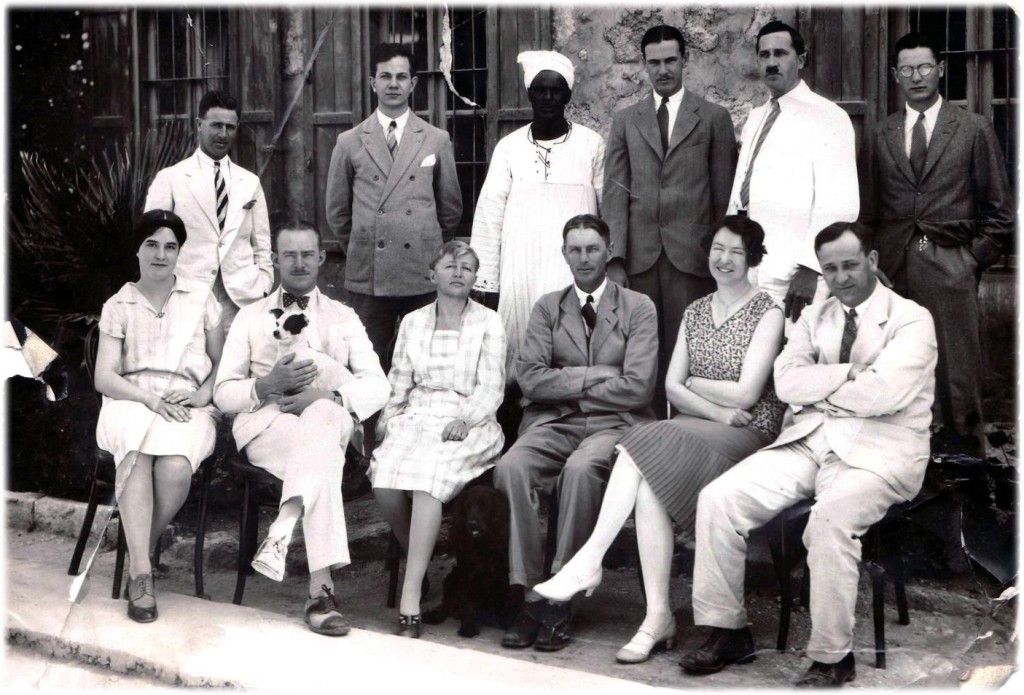
It was therefore with great excitement that Guy on June 4, 1928 sent this cable to James Henry Breasted, the head of the Oriental Institute:
FIRST KINGS NINE FIFTEEN TO NINETEEN AND TEN TWENTYSIX STOP STRATUM FOUR APPARENTLY CORRESPONDS STOP
BELIEVE HAVE FOUND SOLOMONS STABLES
Breasted replied by cable:
CONGRATULATIONS
This fantastic news was subsequently announced to the world via The New York Times on August 8, 1928 and immediately made world headlines.
Combining Two Passages in Kings
The first verses Guy references in his telegram are part of a description of how Solomon’s tax system functioned:
מלכים א ט:טו וְזֶה דְבַר הַמַּס אֲשֶׁר הֶעֱלָה הַמֶּלֶךְ שְׁלֹמֹה לִבְנוֹת אֶת בֵּית יְ־הוָה וְאֶת בֵּיתוֹ וְאֶת הַמִּלּוֹא וְאֵת חוֹמַת יְרוּשָׁלִָם וְאֶת חָצֹר וְאֶת מְגִדּוֹ וְאֶת גָּזֶר.
1 Kings 9:15 Here is the account of the forced labor King Solomon conscripted to build YHWH’s Temple, his own palace, the terraces, the wall of Jerusalem, and Hazor, Megiddo and Gezer.
According to this verse, Solomon invested in building up the city of Megiddo, though the verse does not share any specifics. The second describes Solomon’s massive collection of horses:
מלכים א י:כו וַיֶּאֱסֹף שְׁלֹמֹה רֶכֶב וּפָרָשִׁים וַיְהִי לוֹ אֶלֶף וְאַרְבַּע מֵאוֹת רֶכֶב וּשְׁנֵים עָשָׂר אֶלֶף פָּרָשִׁים וַיַּנְחֵם בְּעָרֵי הָרֶכֶב וְעִם הַמֶּלֶךְ בִּירוּשָׁלִָם.
1 Kings 10:26 Solomon accumulated chariots and horses; he had fourteen hundred chariots and twelve thousand horses, which he kept in the chariot cities and also with him in Jerusalem.
The verse, which tells us of Solomon’s thousands of horses, does not say where they were stabled. By combining these two verses, Guy suggested that they were stabled in Megiddo, and that this was why Solomon invested in that city.
Are They Solomon’s?
Guy’s dating, however, was soon to be challenged. In the early period of biblical archeology, pottery was dated by the building in which it was found, and its presumed date. In this case, when the stables were identified by Guy as “Solomon’s Stables” based on his reading of the biblical verses, the meager pottery associated with them and two other buildings belonging to the same stratum were allocated to Solomon and the 10th century B.C.E. As the science of archaeology developed, however, accepted practice was reversed, and archaeologists began to date buildings by the pottery associated with it.
Ahab’s Stables?
When Yigael Yadin launched his series of small-scale excavations at Megiddo in the 1960s, the ability to date pottery by typology had come a long way. Underneath some of the still unexcavated stable units in the Northern Stable complex (more on this later), in Stratum V, Yadin discovered a monumental building, known as Palace 6000. Yadin, using the latest knowledge regarding dating by pottery typology, immediately dated Palace 6000 to the 10th c BCE and announced that he had discovered a palace belonging to Solomon. The Stratum IV stables, which lay immediately above Palace 6000 therefore, must now be Ahab’s Stables!

His choice of Ahab was based upon what was known from the Kurkh Monolith of King Shalmaneser III of Assyria, which describes the battle of Qarqar and mentions Ahab of Israel third in its list of Assyria’s foes:
I set out from Aleppo and approached the cities of Irḫuleni of Hamath… Qarar, his royal city, I demolished, tore down, and burned. He took his allies, these twelve kings:
1,200 chariots, 1,200 horsemen, 20,000 soldiers of Hadad-ezer of Damascus;
700 chariots, 700 horsemen, 10,000 soldiers of Irḫuleni of Hamath;
2,000 chariots, 10,000 soldiers of Ahab of Israel;
500 soldiers of Byblos…[3]
According to this, Israel had more chariots than either Aram or Hamath, who were listed before him, in addition to his 10,000 foot soldiers.[4]
Jeroboam II’s Stables
The stables remained “Ahab’s Stables” until 2000 when Israel Finkelstein, the co-director of Tel Aviv University’s renewed excavations at Megiddo, launched in 1992, announced a revised date for Stratum IV, based on their excavation results from another part of the site, Area H, as well as in the area of the Northern Stable Complex.

The pottery from Area H firmly placed the construction of Stratum IV, the stable city, in the early part of the 8th century B.C.E. This means that the stables should be dated to the reign of Jeroboam II, perhaps the most successful king in the history of the northern kingdom:
מלכים ב יד:כג בִּשְׁנַת חֲמֵשׁ עֶשְׂרֵה שָׁנָה לַאֲמַצְיָהוּ בֶן יוֹאָשׁ מֶלֶךְ יְהוּדָה מָלַךְ יָרָבְעָם בֶּן יוֹאָשׁ מֶלֶךְ יִשְׂרָאֵל בְּשֹׁמְרוֹן אַרְבָּעִים וְאַחַת שָׁנָה… יד:כה הוּא הֵשִׁיב אֶת גְּבוּל יִשְׂרָאֵל מִלְּבוֹא חֲמָת עַד יָם הָעֲרָבָה כִּדְבַר יְ־הוָה אֱלֹהֵי יִשְׂרָאֵל…
2 Kgs 14:23 In the fifteenth year of King Amaziah son of Joash of Judah, King Jeroboam son of Joash of Israel became king in Samaria—for forty-one years…. 14:25 It was he who restored the territory of Israel from Lebo-hamath to the sea of the Arabah, in accordance with the promise of YHWH, the God of Israel…
Now that we know who built the stables, we must ask what we know about them.
A City for Horses
P.L.O. Guy was an equestrian and had expert knowledge of horses and their care,[5] and thus was able to identify the stables. Although their identification as stables has been questioned over the years by archaeologists, this identification was convincingly confirmed by Deborah Cantrell— also an expert in horses, and with a Ph.D. in Hebrew Bible—in her 2000 book, The Horsemen of Israel.[6]
As Cantrell shows, these areas were clearly designed with horses, and not people, in mind. More significantly, the entire stratum IV seems to have been built with the stables in mind, as the area of the south and north stable complexes together covers nearly half the ancient city!

Southern Stable Complex
The larger area was the Southern Stable Complex, occupying approximately a quarter of the city. It was built on top of an immense laid-down constructional fill that was required to level out and elevate the whole area, which then towered over the rest of the city.

The Southern Stable Complex had two large, identical, square courtyards which were in fact, horse training or horse showing arenas, conforming in all ways to the modern-day requirements for an equestrian arena. They both had a tough, uniformly packed, lime surface.
One arena (Courtyard 977) had five stable units attached to it on its perimeter, and near its center a mudbrick water tank.[7]

|
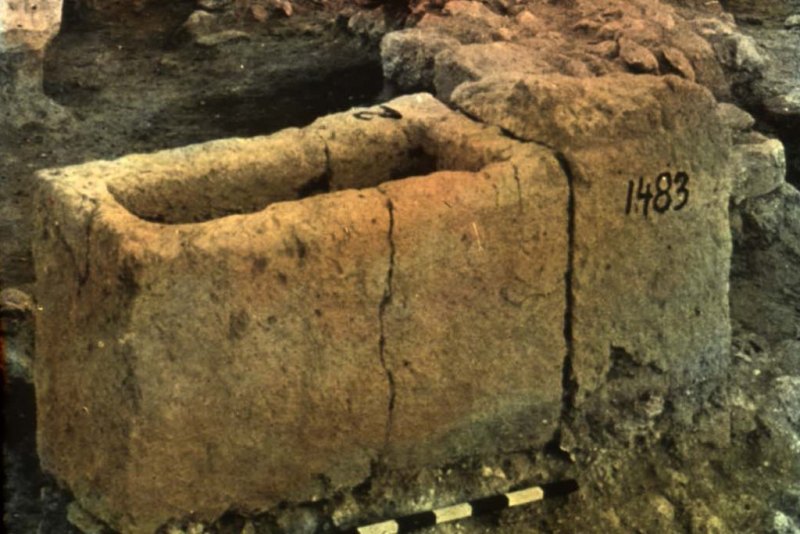
|
The packed lime surface of the arena continued uninterrupted into the central aisle of the each of the five stable units, and flanking each central aisle was a side aisle with a cobblestone floor.
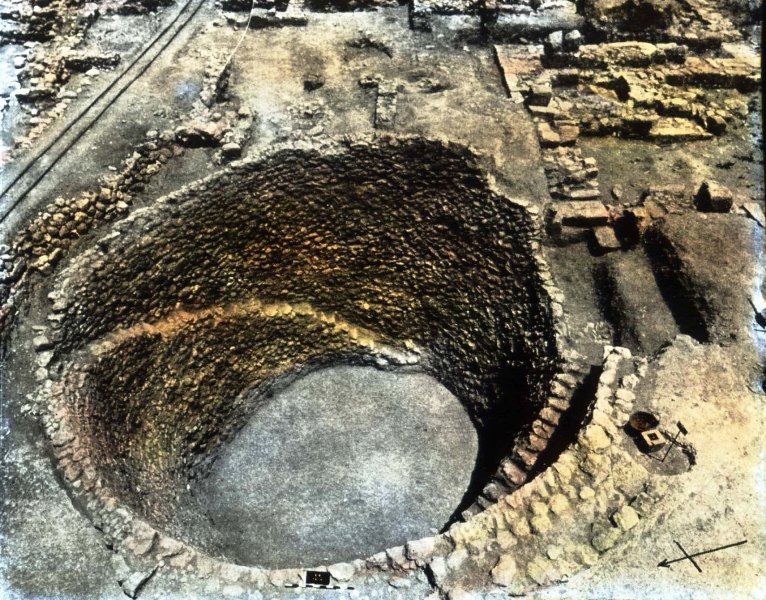
The other arena (Courtyard 1693) had a large building (1616) on its perimeter and on the opposite, city-side, of the arena, a four-chambered gate (1567) that provided access into the heart of the city. Adjacent to the gate was a large subterranean grain silo (1414). Located between the two courtyards, on the perimeter of the mound, was a postern gate that would have conveniently enabled the horses to go out of the city to graze. The hard-packed lime surface extended east and reached a large, well-built, building (338), which possibly the housed the head of Solomon’s chariot force, or even an Assyrian official (rab-kāri).
Northern Stable Complex
The other stable Complex was located to the northeast; here the hard-lime surface transitioned into a gently sloping pebble surface. This complex was comprised of three, or possibly four, buildings with a total of twelve or thirteen, stable units. The two larger buildings, situated opposite one another, had five stable units each. These stable units were stepped down from east to west as the mound sloped gradually down towards the lower ground nearer the city gate.
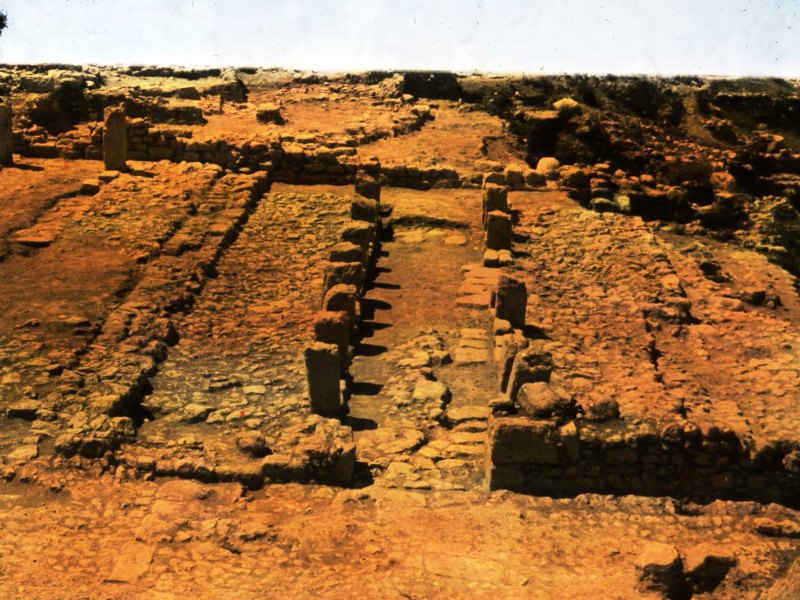
|
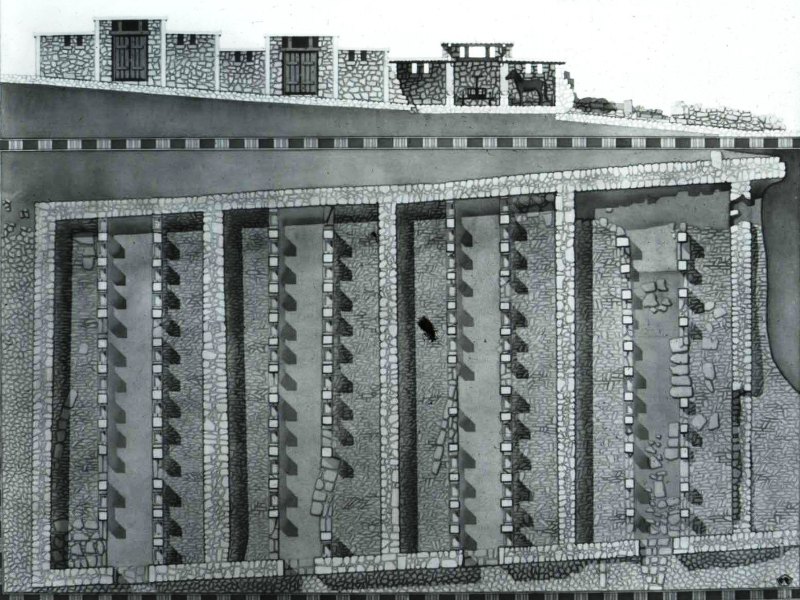
|
Immediately east of these two large stable units was another building with two, slightly larger, stable units. While a fourth smaller, single, stable unit was nearby, possibly more suitable for donkeys. In place of a courtyard, this structure had a wide pebbled roadway (368) that ran from the area of the Northern Stables down towards the city gate.
Why did Jeroboam II transform Megiddo into a city for horses?
Horses, Israelites, and Assyrians
The most expensive traded items in the ancient world were trained chariot horses, and the northern Kingdom of Israel, in particular Megiddo, was an essential link in this trade. The great Assyrian Empire required horses, specifically the large Kushite horses from Egypt, for their chariot teams.[8]
As noted above, Megiddo was located on the Via Maris trade route, an international highway that facilitated trade between Assyria and Egypt. Trade was vital to Assyria, a land with few natural resources, and the Assyrians maintained a network of trade routes (ḫūlāni), and established trading posts (bīt karrāni) at key locations along the route.
Some of the trading posts were located within the territory of independent client-states, i.e., states that paid tribute to Assyria. Israel at the time of Jeroboam II was such a client state, maintaining independence but paying a yearly tribute to Adad-nirari III of Assyria. Assyrian traders (tamkāru), including the royal horse agent (tamkār sisē), would travel these routes in order to obtain whatever the Assyrian king needed. Therefore, transforming Megiddo into a horse training and trading center was economically beneficial to both Israel and Assyria.
Israel as an Assyrian Client State
Assyria was ruled by Adad-nirari III from 805 to 783 B.C.E. and it was during his reign that, according to the Stone Tablet from Calah, Aram-Damascus was finally defeated in 796 B.C.E.
I marched to Damascus. I locked up Mariʾ, King of Damascus, in Damascus, his royal city. The awesome splendour of the god Ashur, my lord, overwhelmed him and he seized my fee and became my servant.[9]
Israel had earlier lost territory from Dan, and as far south, to the Jezreel Valley, to Aram-Damascus, and now courtesy of Assyria it was returned to Israel.[10]
Presumably this was why Joash of Samaria paid tribute to Adad-nirari III as recorded in the contemporary Tell al-Rimaḥ Stele:
To the god Adad, the greatest lord… Adad-Nirari, strong king, king of the universe, king of Assyria… I mustered (my) chariots, troops and camps and ordered (them) to march to the land of Ḫatti. In one year, I submitted at my feet the land of Amurru and the land of Ḫatti. I imposed tax and tribute upon them forever.… He received the tribute of Jehoash of Samaria, of the (people of) Tyre Sidon.[11]
Jehoash’s son, Jeroboam II, came to power a few years later, ruling from ca. 788–747 B.C.E.; he continued to be loyal to Assyria, ruling over his kingdom and the territory regained through the Assyrian conquest of Aram. This period of prosperity is also the period in which the prophet Amos attacks the opulence of Israel’s palaces and ivory houses (Amos 3:11–15).
The good diplomatic relations between Israel and Assyria initiated in 796 B.C.E. continued for ca. 50 years. Assyrian court records, known as the Nimrud Wine Lists, document that for at least the first 12 years of Jeroboam II’s reign, Samarians resided at the Assyrian court. For example, [12]
It was precisely during this period, a period of peace and cooperation between Israel and Assyria, that such a major construction project, as the total rebuilding of Megiddo, transforming it into a city of horses rather than people, could take place.[13]
Assyrian Involvement at Megiddo
Assyrian involvement at Megiddo is very visible. New building techniques imported from Assyria appear for the first time at Iron Age Megiddo, such as ashlar masonry with drafted margins, the use of field-stones with strengthening ashlar piers and marking with red datum lines. In addition, the popular Assyrian cubit of 0.496 m was used on City-gate 2156 and Wall 325, and the stable units were all built using multiples of 8, 10, 12, 36, 40, 60 and 120 Assyrian cubits.[14]
The Southern Stable Complex’s two large equestrian arenas (Courtyards 1693 and 977) each measured 120 x 120 Assyrian cubits, an Assyrian agricultural land measurement known as an iku. In fact, the layout of the Southern Stable Complex is reminiscent of a small-scale Assyrian arsenal known as an ekal māšarti.
The Assyrian arsenal also had two courtyards. One was the kisallu bābānū, the court of the gate, which was
[T]o organise the men, to muster the steeds, the mules, the camels, the chariots, the wagons, the carts, the quivers, the bows and arrows, every category of battle equipment, the harness of the horses (and mules which have much strength [and] are broken to the yoke).[15]
This was Jeroboam II’s Megiddo, a giant training and trade center, designed to deal with the training and selling of hundreds of horses at any one time. Complete chariot squadrons of 20 or 50 chariots, each chariot team consisted of 3 horses, that would have been trained together and therefore be at ease with one another, essential when they had to go into battle together.
These chariot teams from the same stable could be readily incorporated into the great chariot divisions of the Israelite and Assyrian armies. The trade of such a valuable commodity as trained chariot horses would have been overseen by an Assyrian official (rab-kāri) and Assyrian texts imply that Megiddo had a resident rab-kāri.[16]
Jeroboam II’s Megiddo: A Horse Training Center
Combining the archaeological finds with the Assyrian texts and the contemporary political realities reveals that the stable-city of Stratum IV at Megiddo was an incredible military and commercial enterprise. It was constructed by Jeroboam II with the tacit agreement and logistical support of the Assyrians under Adad-nirari III, some two hundred years after what according to biblical chronology, was the reign of Solomon.[17]
TheTorah.com is a 501(c)(3) nonprofit organization.
We rely on the support of readers like you. Please support us.
Published
September 3, 2019
|
Last Updated
December 14, 2025
Previous in the Series
Next in the Series
Before you continue...
Thank you to all our readers who offered their year-end support.
Please help TheTorah.com get off to a strong start in 2025.
Footnotes

Dr. Norma Franklin is a Research Fellow at the Zinman Institute of Archaeology of the University of Haifa and an Associate Fellow of the W.F. Albright Institute for Archaeological Research. She received her Ph.D. from Tel Aviv University. She is the co-directer of the Jezreel Expedition with Dr. Jennie Ebeling. Among her articles are: “Dispelling the fog (אפל) around the Ophel ( עֹפֶל),” “Correlation and Chronology: Samaria and Megiddo Redux,” and “Samaria: From the Bedrock to the Omride Palace.”
Essays on Related Topics:









